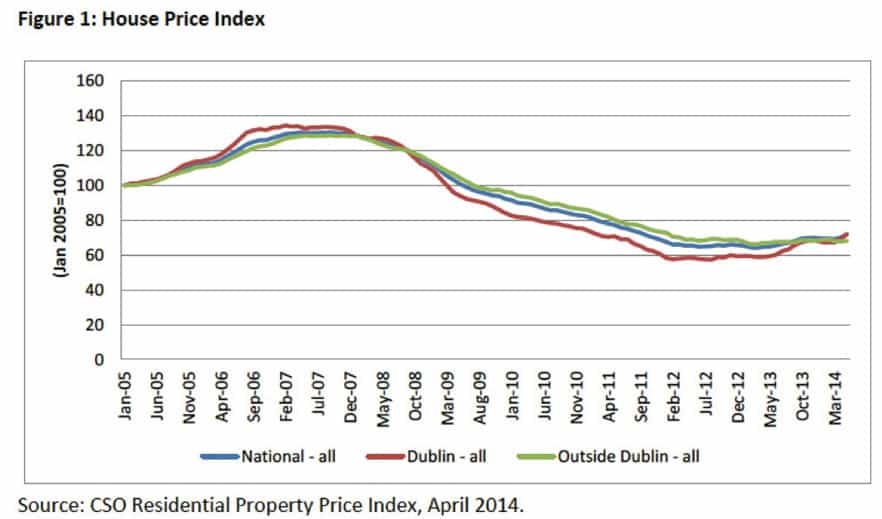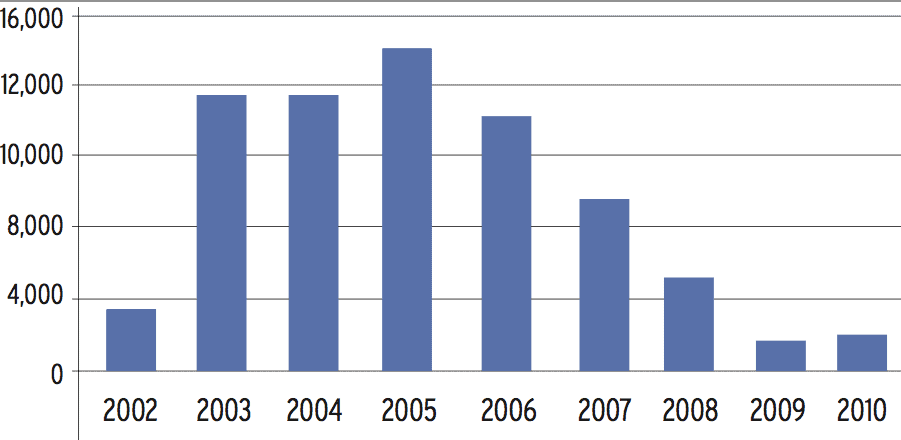Above: Jim Power, economist; Angel Mas, president and CEO of Mortgage Insurance Europe, Genworth; Winsor MacDonell, senior vice president and general counsel, Genworth Canada
Rebuilding the property, construction and mortgage sectors could pay dividends for the economy, the labour market and our financial stability, writes economist, Jim Power.
The Government published its plan of action for the Irish property and construction sector in May. ‘Construction 2020’ recognises the importance of re-building a sector that was decimated after 2008. There are a number of things that a properly functioning economy requires, and one of those is undoubtedly an efficient property and construction sector that will have the capability to meet the future requirements of the economy and Irish society. That is not the case at the moment, following the damage done to the sector after 2007.
The Government report contains 75 action points for the sector, but underlying it all is a clear recognition that it is essential to re-build the sector as quickly as possible. Action point No. 51 recommends that consideration be given to the concept of a universal mortgage insurance scheme, which would allow banks share the risk of mortgage lending, either with the public sector or with private insurance companies.
The key aim of the proposal would be to increase bank lending in general or increase lending to specific target groups. However, it is essential that if demand is to be given a boost, there must be sufficient supply to meet that demand.
If not, any demand-side measures would just lead to undesirable house price inflation.
The Department of Finance is currently finalising its thoughts on the topic of universal mortgage insurance. It remains to be seen what it will advise the Government, but there is reasonably compelling international evidence that it has a key role to play in a functioning mortgage market. Canada is a good example.
Prudential capital
Mortgage lenders here in Ireland are under significant pressure to re-build profitability, reduce the size of the balance sheet and hold adequate levels of prudential capital. High LTV mortgages are in theory more risky than low LTV mortgages, and so they may require higher capital provisioning or may create the perception of a more risky loan book, which could influence the ability of banks to raise capital. It is in this context that mortgage insurance could play a significant role.
At the moment there is some evidence that worthy borrowers with strong repayment capacity based on actual and potential earnings are having difficulty raising a deposit of sufficient size to bridge the gap between the mortgage they are being offered and the price of the house they want to purchase. However, there is not a strong incentive for lenders to engage in such high LTV lending, so some aspiring home owners may be prevented from getting on the property ladder.
Risk mitigation
Mortgage insurance could play a role here. Mortgage insurance is a risk mitigation product that is used to protect mortgage lenders (originators, and/or underwriters) by transferring mortgage risk, and notably tail risk, from lenders to insurers.
The creation of a universal mortgage insurance model would impose a mandatory requirement for all lenders providing high LTV mortgages to put mortgage insurance in place. This would oblige the financial institutions to insure the portion of the high LTV mortgage above a certain level, such as 75%. This would mean that the financial institution would not have to hold expensive capital and thereby would be in a position to offer lower interest rates to borrowers over the lifetime of the mortgage.
Under such a model, the insurer would have an external role in assessing the mortgage transaction, thereby creating better oversight; lenders would not have to hold expensive prudential capital and could offer lower interest costs; higher lending standards would be enforced through the higher level of oversight; the solvency of the financial system would be helped through greater risk diversification; and most importantly first-time buyers in particular would be helped on to the housing ladder, which is important from a social cohesion perspective.

First-time buyers
It would not be prudent to introduce mandatory mortgage insurance for first-time buyers only who are buying a new house. The reality is that not all first-time buyers want to buy a new house. By concentrating only on first-time buyers, important segments of the market would be ignored. The mortgage insurance model should ideally be applied to all high LTV lending. This more holistic approach would help get the overall market functioning more efficiently and more effectively.
Arguably in mortgage insurance had been in place over the past decade, mortgage lending would have been more prudent and the dramatic losses in the financial sector might have been avoided.
However, mortgage insurance is not a panacea for all ills. Rather, it should be part of a mortgage model that is characterised by sustainable debt service coverage ratios, effectively reviewed at regular intervals of time; appropriate LTV ratios combined with a prudent approach to property appraisals; prudent loan to income ratios; effective verification of the borrower’s underlying income capacity; comprehensive file documentation of all loan originations kept over time; and effective collateral management and sound appraisal standards.

Mortgage Insurance in Ireland
Universal model
The universal mortgage insurance model operates successfully in many countries across Europe and elsewhere. It helps ensure a more prudent, stable and liquid housing and mortgage market.
In the UK, the Government introduced a ‘Help to Buy’ scheme, but the Government directly insures lenders for the risk in that part of the mortgage between 80-95% LTV, with lenders retaining a maximum of 0.75% exposure on the loan. This has to date proved very successful in reinvigorating the UK housing market.
However, the UK government is carrying some of the risk. With the proposed Universal Mortgage Insurance Model, this should not be the case.
Market stabilisation
It would not make sense for the State to guarantee any component of the mortgage as this would just serve to increase contingent liabilities on the banks’ balance sheet. This should be left to the private sector through a mortgage insurance model. There are arguments for state intervention in the market in order to help those who cannot get housing, but not in guaranteeing lending where the private sector is already prepared to do so.
Rebuilding a functioning property, construction and mortgage sector would pay huge dividends in terms of economic activity, employment, labour market mobility, financial stability and sustainability, and social cohesion.
Jim Power is an economist and author of economic report, ‘The Potential for Mortgage Insurance in the Irish Market’.





